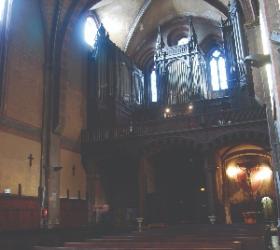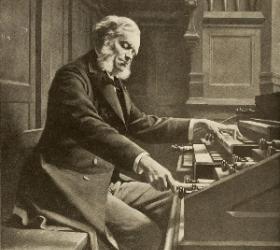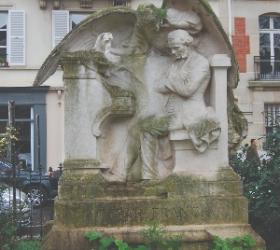
After we had spent the winter in Le Marche, visiting organs by the Venetian Callido and other builders, my wife and I went south to Puglia, living in a farmhouse 20 kilometers down the coast from Bari, burning piles of cut-up brush and tree wood to keep warm, and watching the wildflowers and the fruit trees in our orchard mark the passing time. The Murge is a limestone plateau that makes up much of the interior of Puglia. Altamura is in the High Murge, about 50 km due south of Bari, rising up unexpectedly out of the scrubby olive groves and odd unexplained declivities marked by free stone fences that the rattle-trap graffiti-clad diesel trains of FAL rumble through on their way to Basilicata from Bari.
I had originally wanted to visit Altamura because it is the birthplace of Saverio Mercadante, who grew up playing the flute for change on the steps of the cathedral, lied his way into the Naples Conservatory, and went on to become an important opera composer of the period after Rossini, and a major influence on Verdi. I had also found out that the cathedral had an important historic organ from 1880, built by Turin organbuilder Giacomo Bossi Vegezzi.
If you follow the Corso Federico II di Svevia through the whole old town you pass Mercadante’s childhood home, a four-story building with a dilapidated Spanish air and wrought iron balustrades, and then the cathedral, built out of native white limestone, with some amazing limestone carvings on the front door that depict the life of Christ from a Marian perspective, until finally coming out onto a cedar-shaded piazza overlooking the road to Matera. There is really no Mercadante site or museum in the city; his birth home has a plaque on the side, but people live there and it’s not possible to visit. The cathedral organ soon became the focus of my frequent visits to Altamura.
The Altamura Cathedral organ
The nameplate on the console indicates that it was built in 1880 by the Turin firm of Giacomo Bossi Vegezzi, organbuilders to the King of Italy. While my wife copied down the stoplist, I squeezed into the narrow space between the bench and the console and began to play, barely able to take in, let alone use, the immense selection of reed, flute, principal, and ripieno stops arrayed in four columns before me.
Most of the other historic organs in Puglia are small 18th-century instruments, much smaller than Callido organs, and somehow much less modern—usually just principals, ripieno, and vox humana. The organ in Altamura Cathedral, however, seems gigantic, the biggest two-manual organ I have ever seen. It is a true symphonic organ, because it has timbres that imitate the sounds of an orchestra, and was perhaps designed to play operatic music as it was adapted to the needs of the liturgy—something that might seem strange until you think that the modern Catholic Church has adopted both Latino music and rock music to its new liturgy.
But it is more than just a symphonic instrument, because the quality of the reeds and flutes is strong enough to play organ literature, and among the huge variety of stops each has a clear personality and function that is not duplicated by any other stop. With an organ that big, it takes time to appreciate all it can do. The Italians call two-manual instruments double organs, because they think of them as two organs played by one organist from two keyboards. Even though one organ is usually smaller than the other, they don’t think of one as subservient to the other, like the Choir to the Great, or the Rückpositiv to the Hauptwerk. It is tempting but mistaken to treat one manual as the accompaniment to the other; one must learn to use each manual as a full organ.
The natural literature for this organ, aside from orchestral accompaniment, would be the Italian Romantics, Padre Davide da Bergamo foremost among them. Padre Davide, one of a group of Bergamo composers that included Gaetano Donizetti, seven years his junior, wrote a large variety of organ music, such as flamboyant symphonies that can seem tastelessly theatrical, more somber and restrained offertories, and imitations of bagpipes and other character pieces. His music works very well for the most part on the Altamura Cathedral organ, although his pieces call for things, in terms of both stops and range (low range in the pedals, for instance), that I have never seen anywhere, even on the Serassi organ he used in Piacenza. It seems likely to me that he supplemented the organ as needed with actual woodwinds and brass, and that his organ scores were outlines that would be changed according to the different circumstances and personnel of the concerts.
But it would be a mistake to think that the Altamura Cathedral organ is only good for Italian Romantic music. The solidity of the principals (two sets of 8′ principals and one of 16′ on the big organ) and abrasiveness of the reed stops make this organ suitable for a wide variety of French music and early Italian moderns like Galiera, who wrote fugues influenced by Bach as seen through an early-twentieth-century prism.
Playing most organ music on Italian organs, even Italian music, calls for a continual process of adjustment. Although there are only two manuals on the cathedral organ, each one is divided at middle C, which allows for some independence, but not as much as if there were four manuals, or even three. The problem with the divided keyboard is that melodies often cross middle C. Even Italian music isn’t written to avoid this problem, partly because different organs break at different points, but the fact that solo reed stops in the treble often play at 16′ and in the bass at 4′ means there is a negotiable zone around middle C—for instance, by playing a bass melody an octave lower or a treble melody an octave higher than written.
Perhaps the challenges of writing music specifically for this organ inspired me to take some music, played by a wonderful brass band in the famous Good Friday procession of Noicattero, a Pugliese village walking distance from our farmhouse, and arrange it specifically for the Altamura Cathedral organ. The procession depicts Mary’s search for her son, and features local women wearing veils who assume the persona of Mary; this is depicted in the third of three “Somber Pieces” arranged from this music (p. 22).
Altamura has a different culture from some other Pugliese cities, where, when you come to visit the organ, people in the church sometimes look askance, as if you were crazy. Here, my wife, who would go downstairs to work the recording equipment, was often met by people telling her where there were other interesting and even better organs.
After our first visit to the cathedral, we went looking for a place to eat, and were directed to the Federico II di Svevia, a trattoria with a menu tipico and a back room where we struck up a conversation with a group of men, from middle age to elderly, who adopted us as members of the pack and with whom we came to lunch regularly when we were in Altamura.
The organ in the Church of St. Dominic
After lunch on our first visit we looked for Mercadante scores in the municipal library, housed along with a secondary school in a former Dominican monastery on one side of the cedar-shaded piazza overlooking the Matera road. I noticed the Church of St. Dominic next to the library. We learned that St. Dominic’s also had a Bossi Vegezzi organ, smaller but in better condition than the one in the cathedral.
The St. Dominic instrument, made in 1882, was restored in 2005 by the firm of Fabbrica Organi Continiello Vincenzo. It struck me at first how different its tone is from the cathedral instrument. Even though the stoplist is similar, the St. Dominic organ sounds much more classic, less symphonic and romantic, and I immediately thought it would work well for the big preludes and fugues of J. S. Bach. The difference can’t be explained as the result of an evolution over years in the organ builder’s taste—the two organs were built within two years of each other. Some of the difference may come from the buildings themselves and the location of each organ. The cathedral is a huge Romanesque Gothic building, full of extensive side chapels, and the organ is placed in a traditional Italian way in a loft at one side of the choir, in cornu evangeli, and obviously the sound is diffused by the space. In St. Dominic, on the other hand, the organ is centered on the back wall in a French-style choir loft, and the church itself is a smaller building, with narrow side chapels, whose only architectural extravagance is a Byzantine dome. This is the classical rectangle of great concert halls, where the sound is hardened and focused by the shape of the space.
The organ at the cathedral, perhaps because it has never been restored, gives more of a sense of place. Squeezing into the bench crammed tight against the console, seeing the blue and red draw knobs, the “pedaletti” that were their version of combination stops, gives a real sense of being an organist in 1880. I even finally figured out what the two metal contraptions on either side of the keyboards were. The one on the right had been broken off, but the one on the left was clearly a candle holder, folding out in three sections like a slide rule, with a little cup with a point in the middle for the candle and underneath a larger metal plate to catch the drips!
The firm of Bossi Vegezzi still exists (as Brondino Vegezzi-Bossi) and has made some information about its history, in particular about Giacomo Bossi Vegezzi, available on the web (www.vegezzi-bossi.com). As is usual with organbuilding firms, he was one of a long family tree of organbuilders. Giacomo died in 1883, not long after these organs were built. The interesting part of the story is that at the time of their building, after being a widower, he had taken a second wife, Annetta Vittino, herself the daughter of an organbuilder. She was not only responsible for much of the large-scale operation of the firm while he did the voicing and detail work, but also bore him a son when she was fifty-four. She died in 1886, and her son went on to start his own organbuilding firm, while Giacomo’s son from his first marriage (Carlo Vegezzi-Bossi) continued the Vegezzi-Bossi firm.
St. Dominic’s is run by a lay confraternity, the Confraternity of the Most Holy Rosary. The president of the confraternity invited me to give a concert on September 5 as part of Altamura’s White Night, when the whole city stays up with various concerts and events until dawn. I had spent August in Sicily, because the farmhouse had already been booked for August, and didn’t really have enough time to prepare, but I put together a program that I felt would be feasible. I also found the organ seemed in less good shape than when I first saw it, with some really annoying ciphers in the bass of the principals, both 16′ and 8′.
But all in all, the concert was a good experience. There were people from the church there, and also a group came from the class my wife and I had been taking in pizzica, a form of Barese dancing related to the Sicilian tarantella. I started with Bach’s Prelude and Fugue in E minor, played some arrangements of Cuban music I had made in New York, continued with a Bellini organ sonata and the Largo from Mercadante’s flute concerto in E major, then finished with the Boléro de concert and Elevation by Lefébure-Wély, and Gigout’s Toccata, which in fact is a traditional pizzica melody.
When the concert had finished, after 9 pm, the last train had left, but there was an early morning bus at 4:30 back to Bari, and so we walked around, listening to various rock concerts, watching some groups doing Murgian folk dancing as well as line dancing that could have come from an American International horror movie, and preteens doing dirty dancing that would have put Abigail Breslin in Little Miss Sunshine to shame.
Our regular trattoria was closed for vacation, so we had a nice dinner of typical Murgian antipasti and primi at a pizzeria-restaurant called Don Saverio, on the Piazza Mercadante, before we collapsed on a bench by the cedar-shaded piazza with its Victorian painted glass carousel and the baroque fountain with dolphins and lions, waiting for the bus to arrive.




